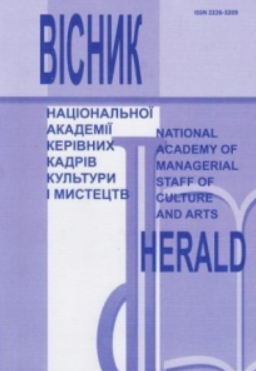АВТОБІОГРАФІЧНІ СЕНСИ ФОРТЕПІАННИХ МІНІАТЮР М. ГЛІНКИ
AUTOBIOGRAPHICAL SENSES IN PIANO MINIATURES BY M. GLINKA
Author(s): Inna Tymchenko-BykhunSubject(s): Music, Aesthetics
Published by: Національна академія керівних кадрів культури і мистецтв
Keywords: piano miniatures by M. Glinka; piano music by M. Glinka as a whole; autobiographical senses of piano miniatures; song-romance lyrics; hidden programmatic; factors of meanings formation;
Summary/Abstract: The purpose of the article is to consider the song-romance area of pianism, according to the proposed classification of piano works by M. Glinka, through the prism of autobiographical character, as the semantic dominant of the composer's piano style. The methodology consists in the application of the method of cultural commentary developed in the works of S. Tishko, also in co-authorship with S. Mamaev and G. Kukol. The specified methodological approach is used as an analytical commentary on a musical text and is implemented using a combination of biographical information and meanings of the work in the context of evolutionary processes and constant features of the composer's style. The scientific novelty of the work lies in the consideration of the piano field of composer's creativity as a single text, directly and indirectly connected by numerous intersections both with the events of Glinka's creative biography and with romantic cultural meanings; in the formation of an idea of the typology of the composer's piano works and the creation of an appropriate classification; in the study of the song-romance sphere of Glinka's piano style through the prism of autobiographical character and thus revealing a whole spectrum of romantic senses of his pianism that were not previously found in musicology. Conclusions. The comprehension of Glinka's piano heritage as a whole allows us to single out the sphere of song-romance lyrics of the composer's piano instrumentalist. An analytical commentary on a musical text, which is realized with the help of a combination of biographical information and the semantic-figurativeness of works in the context of evolutionary processes and constant features of the composer's style, makes it possible to reveal the ways of forming a hidden programmatic and its artistic meaning, as well as to reveal the composer's attraction to the use of words as a factor of meaning formation, to note the importance of autobiographical themes and romantic imagery.
Journal: Вісник Національної академії керівних кадрів культури і мистецтв
- Issue Year: 2021
- Issue No: 1
- Page Range: 152-155
- Page Count: 4
- Language: Ukrainian

